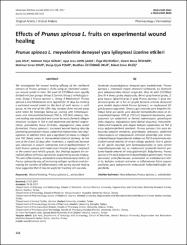| dc.contributor.author | Ayla, Şule | |
| dc.contributor.author | Günal, Yalçın Mehmet | |
| dc.contributor.author | Sayin, Şakul, A. A. | |
| dc.contributor.author | Biçeroğlu, Ö. | |
| dc.contributor.author | Özdemir, E. M. | |
| dc.contributor.author | Okur, Mehmet Evren | |
| dc.date.accessioned | 2019-10-19T14:43:57Z | |
| dc.date.available | 2019-10-19T14:43:57Z | |
| dc.date.issued | 2017 | |
| dc.identifier.issn | 2149-2042 | |
| dc.identifier.uri | https://dx.doi.org/10.5222/MMJ.2017.152 | |
| dc.identifier.uri | https://hdl.handle.net/11421/13313 | |
| dc.description.abstract | We investigated the wound healing efficacy of the methanol extracts of Prunus spinosa L. fruits using an excisional cutaneous wound model in mice. We used 32 C57/Black mice equally divided into four groups. Group 1 Control, Group 2 vehicle (glyce-rine), Group 3 Prunus spinosa L., Group 4 Madecassol. Prunus spinosa L.and Madecassol were applied for 10 days by creating a excisional wound model on the back of each mouse in each group. At the end of the 10th day, samples from wound areas were taken for histologic follow-up, scoring with hematoxylin-eosin and immunohistochemical (TGF-b, COL1A1) staining. Wound healing was evaluated and scored by newly formed collagen structure, increase in TGF b and epidermal and dermal regeneration, granulation tissue thickness, angiogenesis (new vessel formation). Prunus spinosa L. increased wound healing rates by promoting granulation tissue, epidermal regeneration and angiogenesis. In addition there was a significant increase in collagen and TGF [beta] ratios in immunohistochemical staining. At the end of the 4 and 10 days after treatment, a significant increase was observed in wound contraction and re-epithelialization in both Prunus spinosa and madecassol treated groups compared to the control and vehicle groups. Our findings support the beneficial effects of Prunus spinosa for augmenting wound healing. The anti-inflammatory, antioxidant and antibacterial activities of Prunus spinosa by way of increasing collagen synthesis and decreasing the number of inflammatory cells during wound healing have suggested that it may be useful for treating skin wounds | en_US |
| dc.language.iso | tur | en_US |
| dc.publisher | Logos Medical Publishing | en_US |
| dc.relation.isversionof | 10.5222/MMJ.2017.152 | en_US |
| dc.rights | info:eu-repo/semantics/openAccess | en_US |
| dc.subject | Antioxidant | en_US |
| dc.subject | Prunus Spinosa L | en_US |
| dc.subject | Wound Healing | en_US |
| dc.title | Effects of Prunus spinosa L. Fruits on experimental wound healing [Prunus spinosa L. Meyvelerinin deneysel yara iyileşmesi üzerine etkileri] | en_US |
| dc.type | article | en_US |
| dc.relation.journal | Medeniyet medical journal | en_US |
| dc.contributor.department | Anadolu Üniversitesi, Eczacılık Fakültesi, Farmakoloji Anabilim Dalı | en_US |
| dc.identifier.volume | 32 | en_US |
| dc.identifier.issue | 3 | en_US |
| dc.identifier.startpage | 152 | en_US |
| dc.identifier.endpage | 158 | en_US |
| dc.relation.publicationcategory | Makale - Uluslararası Hakemli Dergi - Kurum Öğretim Elemanı | en_US |


















